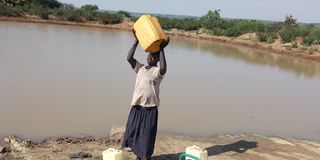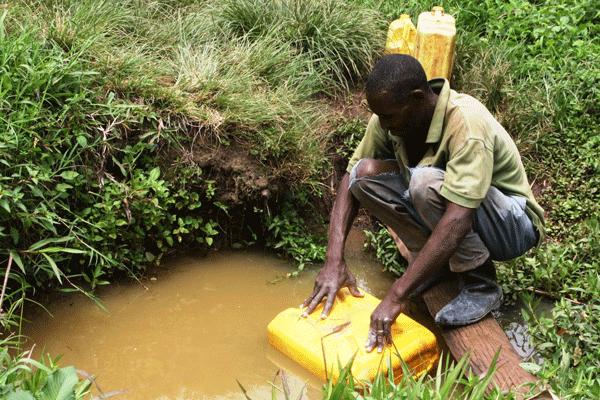Why access to clean water is still a myth in West Nile

A woman carries a jerrycan of water from a dam in Atego Sub-county, Nebbi District, at the weekend. PHOTO/PATRICK OKABA
What you need to know:
Local leaders say due to budget cuts from the central government, the water departments at the district level find it hard to improve accessibility to clean water.
For several years, communities across West Nile Sub-region have been grappling with inaccessibility of clean and safe water.
The situation is worse for Ms Joyce Adia, 46, whose entire life has been dependent on fetching unclean water from River Enyau in Terego District.
“I grew up drinking water from River Enyau. We share this water with animals. People also bath on the river banks,” she said
Ms Adia highlights the need for leaders to address the water crisis for both domestic and production purposes.
“We have been paying taxes all these years and we only hear on the news that valley dams and irrigation facilities have been built in other regions. We need such facilities in our region,” she said.
Similarly, Ms Emily Drijaru, a resident of Madi-Okollo, said those living in remote areas are more affected by the water crisis.
“There is no piped water for communities and children are dropping out of school, especially girls because much of their time is spent looking for water from the stream. When will this situation come to an end?” she wondered.
Ms Drijaru said with the mushrooming population, locals are increasingly struggling to access safe water.
Last week, district leaders and Civil Society Organisations (CSOs) across West Nile region met in Arua District to find solutions to the persistent water crisis, especially during the dry spell.
The Obongi Constituency MP, Dr George Didi Bhoka, said the people of West Nile should petition Parliament on water.
“The issue of water challenges in the sub-region is not a one man’s fight, but it needs a collective responsibility since water plays a key role in the production cycle,” Mr Bhoga said.
Although the government through the Ministry of Water and Environment has made some strides in the provision of clean and safe water through the construction of water points, the statistics put the safe water coverage in Uganda at 66 percent with many residents in rural areas still depending on unprotected water sources including spring wells.
Effects
Mr Emmanuel Wafula, the national project coordinator of Action Aid–Uganda, said due to limited access to clean water in West Nile, cases of domestic violence, cases of school dropouts, and food insecurity will be at its peak.
“The safe water coverage stands at 47.5 percent against the national average of 69 percent. We need partners to work together to improve access to clean and safe water,” Mr Wafula said.
Mr Robert Omito, the chairperson of Pakwach District, said it is extremely getting hard to develop the region, which only depends on rainwater for production.
“West Nile has a very strong workforce, but due to prolonged dry spells, we cannot do much. We need improved technology that can enable water to be drilled, especially in areas with low water tables,” Mr Omito said.
Mr Dominic Iranya, the water officer for Obongi District, said due to budget cuts from the central government, the water departments at the district level are finding it hard to improve accessibility to clean water.
“We still have people walking for two kilometres to access clean water and spend about one hour at the water point. This affects their time to work,” he said.
Mr Iranya said Obongi has a budget of between Shs300 million and Shs400 million annually, which is inadequate to ensure improved access to water for domestic and production use.
This district has a population of 52,000.
Solutions
Mr Geoffrey Abara, the assistant water officer for Pakwach District, said there is a need to lobby for motorised solar-powered water projects.
“Our region has poor water tables due to the soil textures and this hinders the drilling of boreholes. Along the river belts which are sandy and this calls for budget review in the water department in the districts,” Mr Abara said.
Uganda has 138,663 domestic water points, which serves a total of 29,029,053 people, of this, 23,781,181 are in rural areas. An additional 5,312 sources have been non-functional for more than five years and are considered abandoned. Uganda has 1,211 piped schemes.
Globally, as of last year, some 2.2 billion people still lacked access to safe drinking water, according to a July report from the World Health Organisation and the UN children’s agency United Nations International Children’s Emergency Fund (UNICEF). Some 653 million people did not have hand-washing facilities at home.




